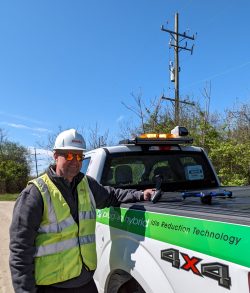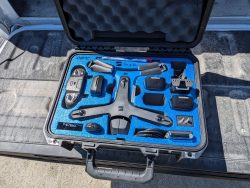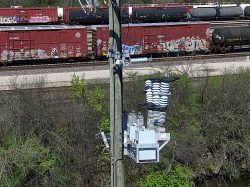
 Meet Matt Seery, a ComEd reliability engineer serving the Joliet area. In his role, he performs in-depth investigations of sites experiencing multiple service interruptions and researches ways to improve system reliability. One way he does this is by flying a drone, or unmanned aircraft system (UAS), a tool that’s relatively new to the energy industry yet is already proving to enhance ComEd’s ability to troubleshoot power interruptions safely and efficiently.
Meet Matt Seery, a ComEd reliability engineer serving the Joliet area. In his role, he performs in-depth investigations of sites experiencing multiple service interruptions and researches ways to improve system reliability. One way he does this is by flying a drone, or unmanned aircraft system (UAS), a tool that’s relatively new to the energy industry yet is already proving to enhance ComEd’s ability to troubleshoot power interruptions safely and efficiently.
“When I first earned my UAS pilot license in 2016, drones were new even to the Federal Aviation Administration (FAA), the federal agency responsible for ensuring the safety and efficiency of air traffic,” said Matt. “At the time, only six of us at ComEd were licensed to use the drones to investigate outages. Today, ComEd has more than 50 craft and engineering pilots ready to take a quicker, closer look at equipment in hard-to-reach areas.”
Using drones, ComEd has been able to assess damage to equipment faster, boost equipment maintenance, and fulfill proactive strategies to protect power infrastructure, all to ensure nation-leading reliability across northern Illinois. Earlier this year, ComEd earned the Chartwell Gold Outage Operations Award for its UAS program, which comprises a fleet of 75 drones capable of sharing data in real time and enhancing utility operations. Drones are used by first responders, Overhead Electrical Specialists, and Reliability Engineers, like Matt, across ComEd’s service territory.
Learn how Matt uses drones to help fix persistent power interruptions and maintain power reliability for the communities of Joliet.
Getting Ready
Matt begins his day reviewing a list of locations where a reliability investigation is needed. He’ll first visit the site, and if he cannot find the cause immediately or reach the equipment on foot, he’ll bring in a ComEd drone to assist him. Before leaving the office – reliability is the name of the game. Matt ensures all batteries are charged, the wings are functional, all cameras on the drone are clean, and weather conditions are safe for flying.

Out on the Field
Before putting the drone into the air, Matt must first submit a flight plan to notify his drone team, the FAA, and the local helicopter group about his flight path. He then dons his PPE (personal protective equipment) and scans the site for birds, protected species, or any other wildlife that may be nearby. Matt then searches for clear spots to send the drone into the sky and begins its mission to review power infrastructure. Controlled from an app on his phone, which enables him to input coordinates using GPS or maneuver manually, he takes photos and video from any angle or height where he can sometimes spot the issue immediately.
 Back in the Office
Back in the Office
Back at his desk, Matt uses the footage he took with the UAS to take a closer look, zooming in on the equipment he saw from 50 feet above the ground. Upon a final evaluation, depending on the level of repair or maintenance needed, Matt will either contact a construction foreman or place a request for ComEd crews to visit the site who will now be able to more efficiently and safely address the problem.
Matt and his drone team are continuously exploring new opportunities to increase the impact of their work. New technologies like Skydio Drone Dock allow drones to be flown remotely from the office, and the team is exploring new platforms to safely fly beyond the visual line of sight, in order to reach equipment located in more difficult-to-reach places. Early efforts to use thermography cameras will allow the team to detect equipment experiencing high heat – a telltale sign of an electric issue.
“It’s really cool I get to incorporate this useful, high-tech tool in the work I do to perform in-depth investigations,” said Matt. “I look forward to how technology will continue to evolve to help us deliver reliable power to our communities.”
The use of drone technology and other advanced systems is a key component of delivering increased reliability performance for ComEd customers. Last year, ComEd achieved the most reliable electric utility in the nation, read more here.
